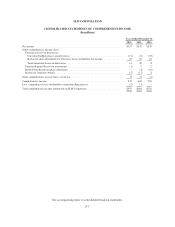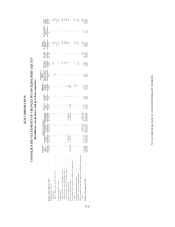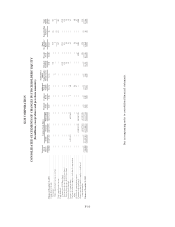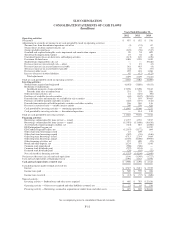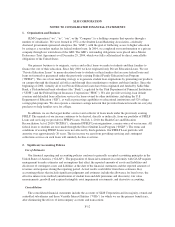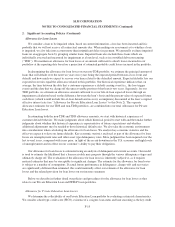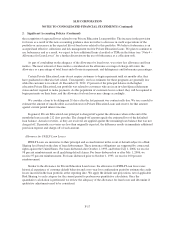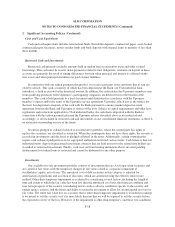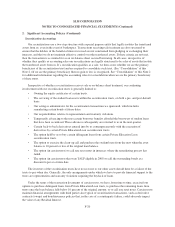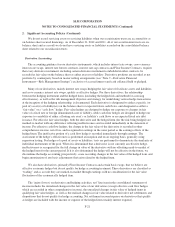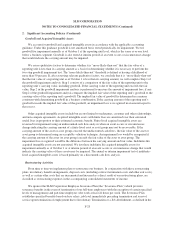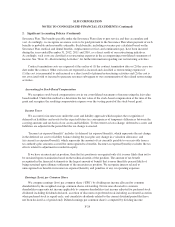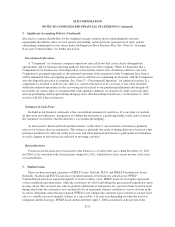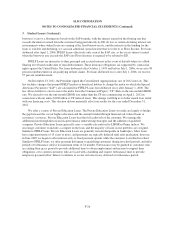Sallie Mae 2012 Annual Report Download - page 127
Download and view the complete annual report
Please find page 127 of the 2012 Sallie Mae annual report below. You can navigate through the pages in the report by either clicking on the pages listed below, or by using the keyword search tool below to find specific information within the annual report.SLM CORPORATION
NOTES TO CONSOLIDATED FINANCIAL STATEMENTS (Continued)
2. Significant Accounting Policies (Continued)
the recognition of expected losses related to our Private Education Loan portfolio. The increase in the provision
for losses as a result of this new accounting guidance does not reflect a decrease in credit expectations of the
portfolio or an increase in the expected life-of-loan losses related to this portfolio. We believe forbearance is an
accepted and effective collections and risk management tool for Private Education Loans. We plan to continue to
use forbearance and as a result, we expect to have additional loans classified as TDRs in the future (see “Note 4 –
Allowance for Loan Losses” for a further discussion on the use of forbearance as a collection tool).
As part of concluding on the adequacy of the allowance for loan losses, we review key allowance and loan
metrics. The most relevant of these metrics considered are the allowance coverage of charge-offs ratio; the
allowance as a percentage of total loans and of loans in repayment; and delinquency and forbearance percentages.
Certain Private Education Loans do not require customers to begin repayment until six months after they
have graduated or otherwise left school. Consequently, our loss estimates for these programs are generally low
while the customer is in school. At December 31, 2012, 15 percent of the principal balance in the higher
education Private Education Loan portfolio was related to customers who are in an in-school/grace/deferment
status and not required to make payments. As this population of customers leaves school, they will be required to
begin payments on their loans, and the allowance for loan losses may change accordingly.
We consider a loan to be delinquent 31 days after the last payment was contractually due. We use a model to
estimate the amount of uncollectible accrued interest on Private Education Loans and reserve for that amount
against current period interest income.
In general, Private Education Loan principal is charged off against the allowance when at the end of the
month the loan exceeds 212 days past due. The charged-off amount equals the estimated loss of the defaulted
loan balance. Actual recoveries, as they are received, are applied against the remaining loan balance that was not
charged off. If periodic recoveries are less than originally expected, the difference results in immediate additional
provision expense and charge-off of such amount.
Allowance for FFELP Loan Losses
FFELP Loans are insured as to their principal and accrued interest in the event of default subject to a Risk
Sharing level based on the date of loan disbursement. These insurance obligations are supported by contractual
rights against the United States. For loans disbursed after October 1, 1993, and before July 1, 2006, we receive
98 percent reimbursement on all qualifying default claims. For loans disbursed on or after July 1, 2006, we
receive 97 percent reimbursement. For loans disbursed prior to October 1, 1993, we receive 100 percent
reimbursement.
Similar to the allowance for Private Education Loan losses, the allowance for FFELP Loan losses uses
historical experience of customer default behavior and a two-year loss confirmation period to estimate the credit
losses incurred in the loan portfolio at the reporting date. We apply the default rate projections, net of applicable
Risk Sharing, to each category for the current period to perform our quantitative calculation. Once the
quantitative calculation is performed, we review the adequacy of the allowance for loan losses and determine if
qualitative adjustments need to be considered.
F-17


